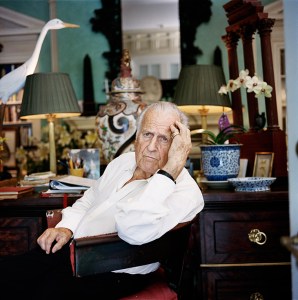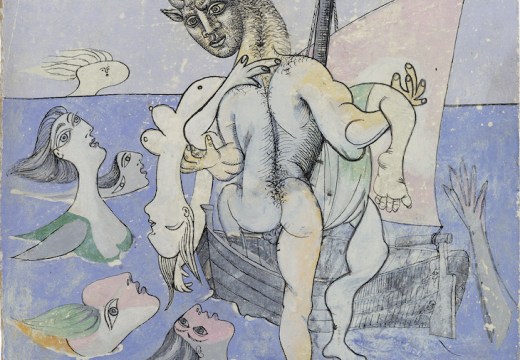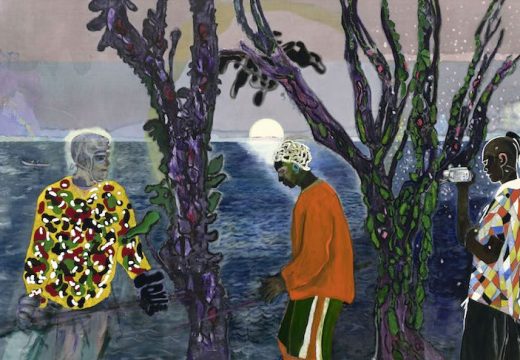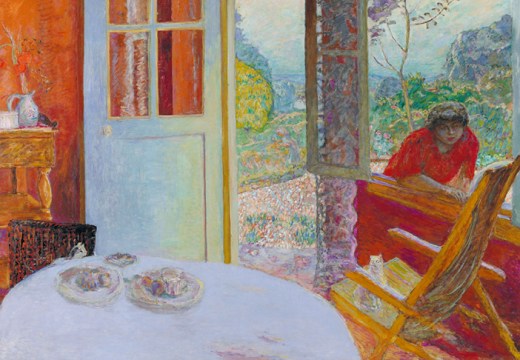John Richardson, until just a few weeks ago, was the youngest person I knew. And when I took my leave of him in mid January, I knew I was saying goodbye to everything that is most alive in New York. That might seem a bit exaggerated. After all, he was on the eve of his 95th birthday and he was already 88 when I met him, first as a committed, experimentally thoughtful member of the Visiting Committee of the Department of European Sculpture at the Met, and becoming, quickly and to my great joy, a close friend.
He impressed me at the first meeting of the committee that I attended, in my role as head of that department, by pointing out something which should by then have been obvious to me – that visitors to museums learn best, when they’re on their own, through comparison: by looking at two objects together (whether Picasso and Braque, or Chinese export porcelain and its Bow imitations). And when we met for lunch shortly afterwards, he floored me with his sharp dress (crimson car shoes in his 80s) and he seduced me with scurrilous, flawlessly funny tales of Angus Wilson, Francis Bacon and others who had better remain nameless. And he wanted to know all about me. He was as eager as a spaniel, almost quivering with energy.

John Richardson (1924–2019) at home in New York. Photograph from his book John Richardson: At Home, published by Rizzoli this month. Courtesy Rizzoli New York; © François Halard
These, I learnt, were some of John’s most important qualities. He loved works of art and he roamed very widely indeed. His was a truly serious vocation. But his dance with the visual was the very opposite of heavy-footed. He was natty in person. He was raffish – not just as a highly accomplished flirt (God, he was good!), but also in the great interiors he created: lavish, louche, high and low, uptown, downtown and everything in between. And he could tell a story like no-one else.
Of course I knew of Sir John Richardson before I knew him in person. I had read his three extraordinary volumes on Picasso and wondered how anyone could combine such insight with such great narrative. In New York, I devoured The Sorcerer’s Apprentice (1999), his account of his years with his lover Douglas Cooper, with whom he met many of the artists who were to become his heroes. It made me laugh, of course, but I also found it unexpectedly touching. This towering figure had once, I discovered, been a little uncertain and vulnerable. I came to understand that every crucial moment in his life had been crystallised into a history or an anecdote.
Some of the details of his life I have only just learnt from his obituaries, but other parts I patched together over the course of seven years of conversations (with me sometimes giving up on any pretence of not quizzing him). He was deeply affected by the death of his elderly father, and more than 80 years later still mourned him. He loved his mother and his sister, and his loves were always strong (so were his loathings). In Oxford during the war, equipped, rather unexpectedly, with a fiancée, he learned he would never be a great artist and he was invited to eat Fuller’s walnut cake with a brain-damaged Unity Mitford; he thought he might have been the last person alive who had known all the Mitfords (Nancy was his least favourite). His friendship with Geoffrey Bennison was one of his most important and influential. He adored John Golding and Bob Silvers and Mercedes Bass and Annette de la Renta. He made his own families.
Above all, John loved being with artists and he talked fascinatingly about Picasso’s sculptural techniques, about watching Braque at work, about his affection for Andy Warhol. In the last couple of years, he was profoundly excited by being carried off to see Julian Schnabel’s working space. Though so superbly English, he was properly cosmopolitan – and his time in France and his move across the Atlantic shaped him as profoundly as his parentage, as it were, in the Army and Navy Stores – which his father, I think, founded.
Indeed, though he was born somewhere else, New York was his native land. He would have thrived anywhere but nowhere else would have so satisfied his insatiable curiosity, his love of art, his commercial savvy (that he worked at Christie’s and Gagosian is just as important as the fact that he wrote for the New York Review of Books) and, yes, his streak of snobbery. When he was heard roundly condemning someone (again, better nameless) newly arrived in New York, for social climbing (‘scritch, scritch, scritch, up the ladder’), a friend pointed out that we all had to do it at one time of another – he too – and that that is the whole point of New York. And then the conversation would veer away, to a higher plane, to describe sitting for Freud or – and I remember his palpable excitement as he thought this through – his theory about Picasso’s debt to Mithraism. He was always eager to know what was new and what you were up to. He was scared of boredom. Just company was not enough; it needed to be stimulating.
Some pictures. John in a huge black fake fur coat that looked more like a gorilla costume than anything else – I called him Mama Tarzan. John about six months ago hurtling out into heavy traffic, crossing Seventh Avenue after a concert at Carnegie Hall – pursued anxiously by me and his beloved Boaz. John queening it over lunch at the Ritz in Paris, planning his next show for Larry. John furious because his design concept for another exhibition had, he judged, been traduced. John at his 90th birthday party celebrating with and celebrated by le tout New York – from the Kissingers to Françoise Gilot to Bette Midler, all rounded out by a bevy of very tall drag queens. John’s spider tattoo. His beautiful ties. His glorious smile. His mock innocence. His occasional drawl. His fake flowers. His great pictures.
Just before writing this I unpacked a box that contained, among other New York flotsam, a pair of cut glass balls that John gave me a few years back. I’m glad to have them. They glitter and scintillate. They’re wonderfully precise and they have a lovely heft. And they’re balls. They’ll be the perfect reminder of John Richardson. Not that I’ll need one.
Luke Syson is the director of the Fitzwilliam Museum, Cambridge. From 2012–19, he was Chairman of European Sculpture and Decorative Arts at the Metropolitan Museum of Art, New York.
Unlimited access from just $16 every 3 months
Subscribe to get unlimited and exclusive access to the top art stories, interviews and exhibition reviews.














![Masterpiece [Re]discovery 2022. Photo: Ben Fisher Photography, courtesy of Masterpiece London](http://www.apollo-magazine.com/wp-content/uploads/2022/07/MPL2022_4263.jpg)
It’s time for the government of London to return to its rightful home